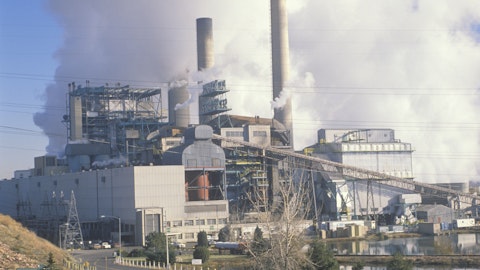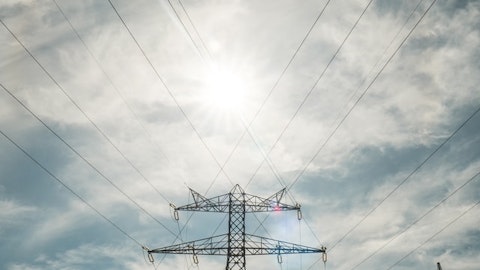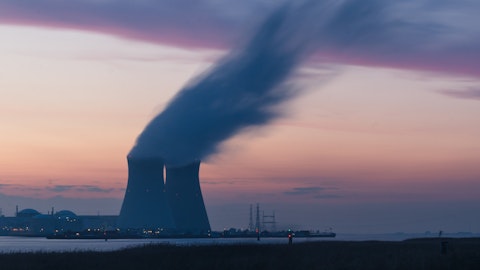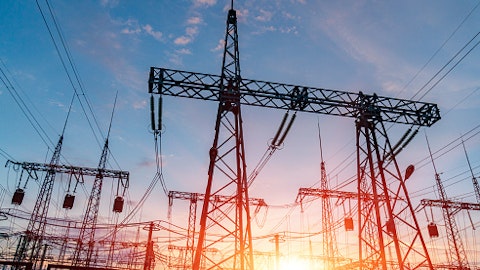CenterPoint Energy, Inc. (NYSE:CNP) Q4 2022 Earnings Call Transcript February 17, 2023
Operator: Good morning, and welcome to CenterPoint Energy’s Fourth Quarter 2022 Earnings Conference Call with senior management. I will now turn the call over to Jackie Richert, Vice President of Investor Relations and Treasurer. Ms. Richert?
Jackie Richert: Good morning, everyone. Welcome to CenterPoint’s earnings conference call. Dave Lesar, our CEO; and Jason Wells, our COO, will discuss the company’s fourth quarter and full year 2022 results. Management will discuss certain topics that will contain projections and other forward-looking information and statements that are based on management’s beliefs, assumptions and information currently available to management. These forward-looking statements are subject to risks and uncertainties. Actual results could differ materially based upon various factors as noted in our Form 10-K, other SEC filings and our earnings materials. We undertake no obligation to revise or update publicly any forward-looking statements. We will be discussing certain non-GAAP measures on today’s call.
When providing guidance, we used a non-GAAP EPS measure of adjusted diluted earnings per share on a consolidated basis referred to as non-GAAP EPS. For information on our guidance methodology and reconciliation of our non-GAAP measures used in providing guidance, please refer to our earnings news release and presentation, both of which can be found under the Investors section on our website. As a reminder, we use our website to announce material information. This call is being recorded. Information on how to access the replay can be found on the website. Now I’d like to turn the discussion over to Dave.
David Lesar: Thank you, Jackie. Good morning, and thank you to everyone joining us for our fourth quarter 2022 earnings call. It’s been nearly 2.5 years since I was appointed CEO here at CenterPoint. They have certainly been eventful, and I am pleased with the significant amount of progress that we have made to managing through a global pandemic, to operating through historically extreme weather, to now navigating the highest rate of inflation the U.S. has seen in the last four decades. I believe this is a management team that can take on and overcome any challenge. Since I got here, there really hasn’t been a dull moment, but make no mistake, I love leading this company and its many great employees. Through these unprecedented times, CenterPoint employees stepped up and continued to deliver results for the benefit of our customers, communities and investors.
And as most of you have seen, when Jason took over as CNP’s President and COO on January 1, we made a few more management changes to make sure that we are creating a deeper bench and continuing to execute on our succession plan to create a company where our employees have the opportunity to be challenged, grow in their careers and help us execute our winning strategy. We have a more diverse leadership team than when I first started and one that has certainly become well regarded in the industry. I firmly believe that we have the right team to execute on what we believe is one of the most tangible, long-term growth plans in the industry. And of course, we continue to execute well. I’m happy to share that the fourth quarter of 2022 is our 11th consecutive quarter of meeting or exceeding earnings guidance expectations.
Today, we announced fourth quarter non-GAAP EPS of $0.28 and full year non-GAAP EPS of $1.38. This annual 9% growth rate over 2021 establishes a new higher base from which we will grow our annual earnings for the balance of our plan through 2030. Also keep in mind, we also grew non-GAAP EPS by 9% in 2021. At CenterPoint, we don’t use CAGRs for our EPS growth. We are focused on growing off our delivered results each and every year. Today, we are also reaffirming our 2023 non-GAAP EPS guidance range of $1.48 to $1.50, an 8% growth rate at the midpoint from the new higher base of $1.38. Jason and I believe in having transparency with our business operations, so we can present our investors visibility into our performance by having one of the tightest guidance ranges in one of the longest duration growth rate targets in the industry.
I also want to highlight what else we accomplished just last year. We became a pure play regulated utility with the complete divestiture of our investment in Energy Transfer in March of 2022. For the benefit of our stakeholders, we recycle those sales proceeds back into our regulated businesses. As a result of this divestiture, well over 95% of our earnings now come from our regulated utility operations. We closed on the sale of our Arkansas and Oklahoma LDCs for which we received a landmark valuation and once again, we were able to use the sale proceeds to further invest in our regulated businesses for the benefit of both our customers and investors. We completed the final few steps of our Vectren integration, which resulted in a better aligned operational and financing structure to benefit customers and investors going forward.
Additionally, we’ve made great progress on our Indiana Integrated Resource Plan with the approval of the 460-megawatt gas plant earlier this year. The filings for several renewable projects, including our first wind project and as Jason will discuss, the regulatory approval for the first of its kind Indiana securitization of the A.B. Brown coal facility in early January of this year. As we progress on our IRP, we continue to advance towards achieving our net zero carbon emission goals. And finally – in the third quarter of 2022, we increased our 10 year capital plan by $2.3 billion, taking it from $40 billion plus through 2030 to now $43 billion through 2030 with a focus on additional investments in grid reliability and modernization. This $2.3 billion in additional planned capital should not only allow us to provide safer and more reliable energy for our customers, but should also allow us to continue to reduce O&M over the longer term, which additionally benefits both customers and investors alike.
As we have stated in the past, the current capital plan can still be executed with no external equity issuance. On top of the $2.3 billion we formally added to our capital plan, we’ve also identified an additional $3 billion of other potential capital opportunities. As we’ve said, we will fold in this additional $3 billion of capital when we believe we can operationally execute it, efficiently fund it and minimize the regulatory lag associated in recovering it. 2022 was truly an exciting and productive year here at CenterPoint, and we are confident that this strong momentum will continue into the New Year. Now turning to our earnings guidance. As I stated at the top of my remarks, we earned $0.28 of non-GAAP EPS for the fourth quarter of 2022 and $1.38 for a full year 2022.
This represents a 9% growth rate when compared to our 2021 non-GAAP utility EPS. We continue to expect to grow non-GAAP EPS 8% in both 2023 and 2024 and in the mid to high end of the 6% to 8% thereafter annually through 2030. This is an industry leading growth rate. Jason will provide additional details regarding our financial results later. Now let’s move to capital investments. In the fourth quarter of 2022, we deployed a CenterPoint record $1.6 billion of capital across our various jurisdictions, bringing our total capital invested for the year to $4.8 billion. The $1.6 billion of fourth quarter capital was approximately $200 million above what we previously indicated on our third quarter call. Some of this increase was due to initial investments made to facilitate the expansion of an already world-class facility, the Texas Medical Center, or TMC, as it begins its expansion to double its size over the next 5 years or so.
Over those next 5 years, we are anticipating investing over $200 million in the TMC and surrounding community. These investments will consist of a large new substation and several system hardening projects, impacting and strengthening the resiliency in the TMC area. This will also include reinforcing transmission and distribution lines and strengthening current substation equipment. The expansion of the TMC exemplifies the continued growth in the Houston area as it remains an attractive city in which to live and work. So for those of you that worried that our organic growth would slow post-COVID, it just has not happened. Let’s look at the numbers. Since the COVID recession, the state of Texas has added nearly 1.1 million jobs, a testament to the underlying fundamental strength of the Texas economy as a whole.
Looking at things more locally. Amazingly, over the past year, the Greater Houston area saw record employment growth with an estimated 179,000 jobs added. It also saw its population increase by almost 300,000 people to nearly 7 million. This is now like adding a city the size of Irvine, California to our footprint in just 1 year. We see this trend continuing as the Texas miracle keeps humming along. Housing starts for the combined Houston and Dallas area over the last year saw a combined 153,000 housing permits in 2022, nearly 40,000 more units than the entire state of California during the same period, which has nearly 25 million more people. This business and residential organic growth continues to drive the potential for the additional upside to our existing $43 billion 10 year capital plan that I discussed earlier.
Therefore, our plan also allows for flexibility and potential capital spend upside through 2030 and beyond as we see additional opportunities to support our customers own growth plans. This growth is just one of the reasons we believe we are uniquely positioned as a company. Despite the many moving parts impacting our plan, we remain confident in our continued ability to execute this industry-leading growth plan. We’ve taken a conservative approach to estimating organic growth and weather trends, among other assumptions, which we see as potential tailwinds to offset the headwinds of higher interest rates, inflation and other potential unknown issues that always arise in business. Additionally, our regulatory return assumptions across all of our jurisdictions are generally consistent with what we currently have approved by our various regulators, and we are using to manage our business today.
With all that being said, one of our key priorities is always to limit the impact of our investments on customer bills, especially during these times of high inflation, rising interest rates and a potential recession. We believe our capital plan not only benefits customers from a service reliability standpoint, but also from an affordability perspective as well. For example, in the Houston area, which has the highest concentration of our planned capital spend through 2030, we anticipate that these investments, in combination with our O&M reduction goals, and securitization charges rolling off, should result in an average customer bill increase of only 2% or less per year, well below current inflation rates. We are also encouraged by the recent decline in natural gas prices, which should create some downward pressure on utility bills.
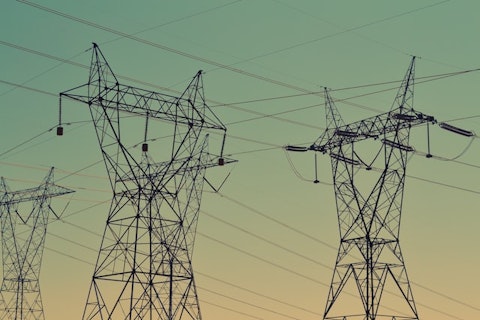
Photo by Fré Sonneveld on Unsplash
We believe our capital plan around modernization of the grid here in Houston will enhance the customer experience for both our new and existing customers. It will also help accommodate the immense residential and industrial growth the Houston region is now experiencing. These investments should help reduce widespread outages and, in turn, reduce service calls. Fewer service calls, a more reliable system and a strong growing organic customer base in the Houston area is also the perfect combination for us to stay on our path of 1% to 2% average annual O&M reductions over the 10 years of our plan. Next, I want to also briefly discuss where we are in our CFO search. First, Jason and I have been thrilled with both the number and quality of the applicants for the CFO position.
So far, the process has confirmed what we already knew: This is a really attractive job at a really great company. We are in the process of evaluating candidates to make sure we find someone who will provide a complementary skill set and be a good fit with the rest of our great team we already have in place. And so to close, 2022 was a great year here at CenterPoint, and all of our customers, employees and shareholders have a lot to celebrate. But we remain very much focused on building a long-term track record of execution for our investors and maintaining affordability for our customers. We continue to believe we have one of the most tangible growth plans in the industry as we are uniquely positioned with great opportunities to better serve our growing customer base.
Continued organic customer growth, especially in the Houston area and our opportunities to reduce O&M give us confidence that we can execute our plan. I think I speak for all of us at CenterPoint, when I say that we are looking forward to 2023 and building upon an already strong premium utility investment thesis. Finally, I want to acknowledge and thank all of the CenterPoint employees for a job well done last year, especially those that work through the year-end holidays to ensure the lights stayed on for our customers during the record cold weather that hit millions across the U.S. and also the recent tornado that devastated the cities of Deer Park and Pasadena and surrounding communities in the Houston area. This tornado stayed on the ground for 18 miles and caused more damage than any tornado in Texas in the past 30 years.
This management team and all of the employees here at CenterPoint understand our unique responsibility in all of our service territories and appreciate the opportunity to serve our approximately 7 million metered customers. With that, I’m going to turn the call over to Jason.
Jason Wells: Thank you, Dave, and thank you to all of you for joining us this morning for our fourth quarter call. I want to echo Dave’s thanks to all of our employees here at CenterPoint and express my sincere gratitude for the great work of our teams during these recent periods of inclement weather. From those who sacrificed their holidays so that customers throughout our service territories could enjoy theirs to those that helped recently resource service after the extreme tornado activity in late January. And now recently, the crews who have helped with the restoration efforts after the recent ice storms in other parts of Texas. It shows we have a committed and talented workforce dedicated to delivering for our customers and our shareholders.
I’ll start by covering the financial results for the quarter, shown on Slide 5. On a GAAP EPS basis, we reported $0.19 for the fourth quarter of 2022. As in previous quarters, our GAAP EPS results include a portion of the tax on the gain on sale of our Arkansas and Oklahoma gas LDCs, which we are required under GAAP to recognize over the course of the full year. The quarterly results also include a onetime non=-cash charge of $0.06, net of tax, related to the derisking of our long-term pension exposure, which I’ll discuss in more detail in a few minutes. On a full year basis, we reported $1.59 per share, which also included the gains from the sale of the previously mentioned gas LDCs in addition to the sales of the Energy Transfer common and preferred partnership units earlier this year.
On a non-GAAP basis, we reported $0.28 for the quarter of 2022 compared to $0.27 in the fourth quarter of 2021, and $1.38 for the full year of 2022 as compared to $1.27 for the full year of 2021. This is 9% growth on top of 2021, in which we also grew 9%. This is an industry-leading growth rate. Growth and rate recovery contributed $0.06, largely driven by continued rate recovery through our electric distribution capital tracker, the DCRF, and our electric transmission tracker, TCOS in our Houston Electric territory. In addition, we continue to see strong organic growth in the Houston area with another nearly 2% increase in residential growth over last year. Weather and usage for the fourth quarter was also a favorable $0.02 when compared to the same quarter of 2021, driven by a combination of extremely mild weather in the fourth quarter of 2021 as compared to a more seasonally normal weather in the fourth quarter of 2022.
These favorable drivers were partially offset by higher interest expense of $0.06, primarily driven by higher interest rates and $0.01 related to absorbing costs previously allocated to our midstream segment in 2021. I want to briefly touch on O&M for a moment. We continue to find savings opportunities to achieve our reduction target of 1% to 2% per year on average over the course of our 10 year plan through 2030. For the year, we were $0.02 unfavorable as compared to last year. However, as you will remember, due to favorable weather during last summer’s hot months, we were able to pull forward O&M from 2023 for the benefit of our customers. This is consistent with the approach we used in 2021, and should we have weather benefits in 2023, we will certainly contemplate doing so again.
Overall, I continue to remain pleased with our ability to drive efficiencies in our business and remain confident we can continue delivering on our goal of reducing O&M 1% to 2% annually on average. As Dave mentioned, we are reaffirming the full year 2023 guidance range of $1.48 to $1.50 of non-GAAP EPS, which reflects 8% growth over the full year 2022 non-GAAP EPS of $1.38 when using the midpoint of the previously increased guidance range. Beyond 2023, and from the reaffirmed 2023 guidance of $1.48 to $1.50, we continue to expect to grow non-GAAP EPS 8% in 2024 at the mid to high end of 6% to 8% annually thereafter through 2030. Our focus continues to be on delivering strong industry-leading growth each and every year. Turning to capital investments on Slide 7.
As Dave mentioned, for the benefit of our customers, we invested $1.6 billion in the fourth quarter and $4.8 billion over the full year in 2022. This is a $1 billion or a 25% increase from the target we provided at last year’s Analyst Day. Much of this increase was due to our nearly $500 million investment in our temporary emergency mobile generation units and the accelerated resiliency-related investments we pulled forward as part of the nearly $3 billion increase to our capital plan outlined on our third quarter earnings call. The capital that was pulled forward to 2022 included capital deployed in the fourth quarter to support the rapidly expanding Texas Medical Center. All of these investments are driven by our continued focus on safety, resiliency, reliability, growth and clean energy enablement of our service.
Turning to our generation-related investments. We’ve made good progress on our current integrated resource plan, including the last filing for generation and owned wind project that we expect to come online sometime in 2024 or early 2025, and the IURC’s approval of our 130-megawatt owned solar project, and we refiled PPAs associated with two solar facilities to accommodate various developer price increases. These projects, in addition to the ones already in service, total approximately 800 megawatts of expected owned and contracted solar generation, which tracks well against our IRP goals that called for approximately 700 to 1,000 megawatts of solar and approximately 300 megawatts of wind. As it stands for the current projects, we expect to own approximately 60% of our renewable generation and contract for the remaining roughly 40%.
With that said, and with recent changes in law, namely the Inflation Reduction Act, the proportion of owned and contracted renewables may be different for additional projects included in our next IRP, which we plan to file in the middle of this year. This upcoming IRP should provide guidance on our remaining coal-fired assets. As we’ve mentioned before, as a foundation for this IRP, earlier this year, we conducted an all-source request for proposal where we received nearly 100 proposals from several dozen participants, including wind, solar and battery storage that will help inform our IRP process. We look forward to working with stakeholders through the IRP process to develop a constructive outcome for our customers that allows customers to achieve bill savings through efficient renewable generation rather than coal generation, which requires significant ongoing O&M expense.
Moving to a broader regulatory update on Slide 8. We have securitization efforts continuing in a couple of jurisdictions. We anticipate receiving securitization proceeds in the coming months in Texas related to the incremental natural gas costs related to Winter Storm Uri, which will securitize approximately $1.1 billion of these costs. We had anticipated receiving these proceeds before year-end 2022, but it has been delayed. This delay has been driven by various stakeholders in Texas exploring alternatives, including potentially appropriating state surplus funds to pay this off in whole or in part for the benefit of our customers. We are supportive of this customer-focused process and anticipate resolution soon. In addition to the Texas securitization, we recently received approval for our Indiana securitization for approximately $350 million of costs related to the retirement of two coal facilities.
This is a first-of-its-kind filing in Indiana allowing for more affordable transition to cleaner generation sources for the residents of Southern Indiana. We want to thank all stakeholders, including the Indiana Utility Regulatory Commission in working through this unique process to achieve a constructive outcome for our customers. Beyond the securitizations, we will continue to recover the $78 million in Texas related to the traditional distribution capital portion of the DCRF, which went into rates in September. We recently received a proposal for a decision from the administrative law judges at the State Office of Administrative Hearings, an agency that is separate from the PUC, recommending to the PUC the disallowance of recovery of our temporary emergency generation units.
We’re disappointed in this proposed decision as we don’t believe this is the correct reading of the law, and now that the case is back in front of the PUC for a final decision, we look forward to a constructive resolution in this case. As a reminder, we invested in these units following Winter Storm Uri, where more than half of our Houston area customers were without power for extended periods of time. Texas lawmakers acted quickly and decisively after that event to enact certain measures that would mitigate the impacts of severe weather to Texans. The passing of the bill will allow Texas T&D companies to use temporary emergency mobile generation, which can aid in reducing the number and or duration of outages during significant load shed events was perhaps the most significant mitigation measure passed into law following Winter Storm Uri.
In fact, these units were deployed as recently as a few weeks ago to get children back into the classroom after previously discussed tornadoes cost outages throughout the Houston Metro area. And just last week, we set some of our units to Austin to be ready to assist in recovery efforts from the recent ice storms. We have and we will continue to advocate vigorously for the use of this critical tool for the benefit of our customers and in a manner that is consistent with the law. We expect a final ruling on our 2022 filing by the end of the first quarter. Lastly, to cover some credit-related topics. As of the fourth quarter, aligning with Moody’s methodology, our FFO to debt as reported was slightly below 14% and approximately 15% when adjusted for the $1.1 billion of outstanding debt related to Winter Storm Uri extraordinary gas costs.
As a reminder, we are deferring the interest expense associated with this debt balance until the state wide securitization is issued. As I mentioned, we had anticipated receiving the bond proceeds associated with the Texas securitization before the start of 2023, which, in part, is the reason why we’re carrying higher than expected levels of commercial paper and floating rate debt at year-end. When we receive those proceeds, we plan to pay down a mix of floating rate debt and high coupon debt. In addition, we also saw higher gas prices and usage during the December cold stop which also led to elevated levels of variable rate debt that we believe will be transient in nature as we expect to collect the majority of this balance over the coming months.
To revisit the pension item I discussed a few minutes ago, we entered into an annuity lift out, whereby roughly $140 million of pension plan obligations and corresponding plan assets related to previously divested businesses were transferred to an insurance company. This transaction allowed us to derisk our future obligations for which we don’t receive regulatory deferral. As we previously mentioned, we get deferral on approximately two thirds of our pension expense. As a result of this lift out, we recognized a non-cash settlement charge of $47 million, which represented the acceleration of unrecognized losses deferred under the pension smoothing rules. Through a combination of an increase in discount rates and lump sum settlements, including the annuity lift out, our total pension liability was reduced in 2022 by approximately one third or $700 million.
Our strong cash flow from operations, coupled with our efficient recycling of capital, puts us in a position of still being able to offer industry-leading growth that doesn’t require external equity to fund our current 10 year capital plan through 2030. Those are my updates for the quarter. As we continue to express, we take our commitment to be good stewards of your investment very seriously and realize our obligation to optimize stakeholder value. Now with that, I’ll turn the call back over to Dave.
David Lesar: Thank you, Jason. As you’ve heard from us today, we have 11 straight quarters of meeting or exceeding expectations. We are a pure play, regulated, premium utility and on a course of continuous execution of our plan with incremental growth opportunities to support our customers.
See also 15 Most Promising Mid-cap Stocks and 12 Most Promising Micro Cap Stocks.
Q&A Session
Follow Centerpoint Energy Inc (NYSE:CNP)
Follow Centerpoint Energy Inc (NYSE:CNP)
Receive real-time insider trading and news alerts
Jackie Richert: Thank you, Dave, and thank you for all of you for joining. We’ll now turn the call over to Q&A. Operator?
Q – Shahriar Pourreza: Hey, guys. Good morning.
David Lesar: Good morning, Shahriar.
Shahriar Pourreza: Jason, I wanted to start off with a question on the capital markets environment and how you’re sort of thinking about debt metrics at this point. Deferred costs have obviously been elevated, including fuel. You had a securitization delay in ’22. You’ve seen around a $0.06 of incremental interest drag across the utilities and parent in 4Q. I guess how should we think about resolving some of these carried costs and managing the interest rate experience cost pressures in the near term?
David Lesar: Let me – yes, let me ask Jason to put a CFO hat back on for a minute and answer that one.
Jason Wells: Yeah. Good morning, Shahriar. I appreciate the question. Obviously, we’re not immune to the interest rate headwinds that everybody is facing these days, but we’re confident we can manage through this challenge as we continue to have more tailwinds than we do headwinds overall. As it relates to kind of interest expense, let me make a couple of points. First is we saw interest rates rising last year. We embedded conservative assumptions around interest rate costs in the ’23 guidance that we initiated on the third quarter call. So I can – I feel confident that we can accommodate some of the variability that we’ve recently haven’t seen. The second thing, and as I kind of touched on it in my prepared remarks, we ended the year with slightly higher elevated working capital balances due to higher gas costs that we were purchasing in late third quarter, early fourth quarter.
As gas prices have come down now, we expect those working capital balances to turn pretty quickly. That should take a little bit of pressure off. And then as you mentioned, while we get to defer the interest expense on the extraordinary gas costs from Winter Storm Uri here in Texas, we still anticipate receiving $1.1 billion in securitization proceeds in the coming future, and that will really help reduce the overall variable rate exposure. So again, we feel confident that we can manage through any interest rate headwinds.
Shahriar Pourreza: Perfect. And then just lastly for me, just maybe touching base on sort of the expectations for the upcoming Texas rate case. I know we’ve had some data points from the Encore process and despite the confusion with the PFD, which was eventually rectified, there seem to be really a focus on finding rate relief for customers and other peers obviously in settlement discussions. Just maybe from a high level, Dave, what are sort of the major categories of that revenue relief you anticipate seeking? Is it primary rate base, is it deferred costs, is it O&M true-ups? And do you anticipate a noticeable rate increase from the ’24 filing? Or do you think you guys have enough levers in plan to show even a potential rate reduction despite the ask? Thanks.
David Lesar: Well, that’s a handful of a question. Let me just answer it by saying, I don’t think it behoves us to try to front run what might happen, what bills might get put in. We’re early in the session. Jason, Ryan and his team are heavily engaged in Austin with respect to looking at opportunities that are going to be primarily focused on making sure we keep customer bills under control. But I don’t think it would make any sense at this point to talk about specific efforts or bills that we would like to see put forward. I would just say watch this space. And I think when we come with our first quarter call, which will be later this spring, we’ll be way more into the session at that point in time. And I think you and all of us will have a better idea where that might be headed and what bills are likely to get passed.
